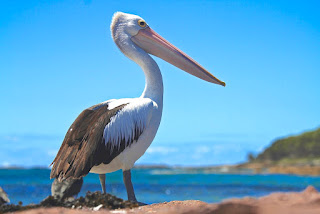
The pelican is a magnificent bird that can be found on all continents except Antarctica. Pelicans are classified into eight species. These birds are typically found in warm climates near rivers, estuaries, and lakes. Water pollution, chemical pollution, and major ecological disasters such as oil spills endanger pelicans. Another reason for the decline in the number of pelicans is bycatch: pelicans can become entangled in fishing nets while diving for fish. Brown pelicans are on the endangered species list.
Interesting facts about Pelicans:
One of the largest birds is the pelican. They can grow to be 4 to 6 inches long and weigh between 10 and 30 pounds.
The largest bill of any bird is that of the pelican. It can grow to be 18 inches long. Pelicans have a throat pouch beneath their bills that can hold 3 gallons of water.
The pouch is primarily used for feeding, but it can also function as a cooling “device.” Pelicans will swing their pouches to keep cool on hot days.
The pelican is easily identified by its large body, short legs with webbed feet, and 10-foot wingspan.
Pelicans are heavy birds, but buoyancy is not an issue thanks to air sacs in their bones. Using warm wind currents, they can fly to a height of 10,000 feet.
Swimming and diving require webbed feet. Pelicans will identify potential prey from the sky and catch it by accelerating quickly toward it.
Pelicans primarily consume fish. Aside from that, they can eat turtles, crustaceans, and tadpoles. Pelicans that are extremely hungry will even attack and eat seagulls.
Pelicans frequently hunt in groups. They will use their wings to splash the surface of the water, forcing the fish into shallow water where they can easily scoop it up with their bills.
Pelicans will consume a large amount of water along with fish. Pelicans move their heads forward to remove excess water before swallowing the fish. Pelicans can consume up to 4 pounds of fish per day.
Pelicans are gregarious birds. They live in large colonies made up of hundreds of birds.
Certain pelican species can mate all year, while others only mate seasonally.
During mating season, males employ a variety of strategies to attract females. Some males have colorful feathers, while others can change the color of their pouch, neck, and bill during courtship.
Both males and females are in charge of constructing the nests, which are usually found in trees near bodies of water. Feathers, leaves, and sticks are used to construct nests.
Females lay one to three eggs. The incubation period lasts 28 to 36 days. Young pelicans eat by scooping food from their parents’ bills.
In the wild, pelicans can live for 10 to 30 years.









